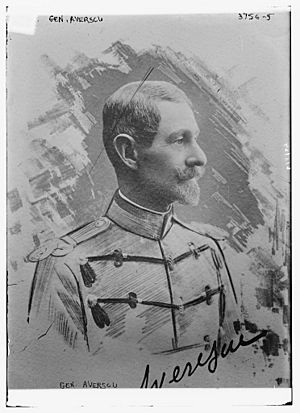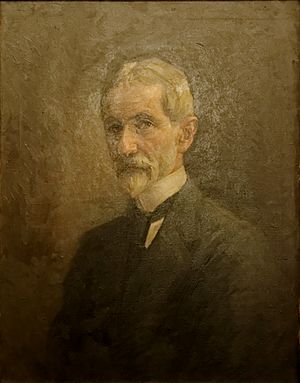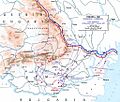Alexandru Averescu facts for kids
Quick facts for kids
Marshal
Alexandru Averescu
|
|
|---|---|
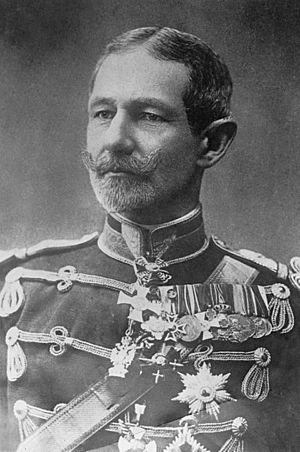
General Alexandru Averescu, photographed ca. 1916
|
|
| 24th Prime Minister of Romania | |
| In office 29 January 1918 – 4 March 1918 |
|
| Monarch | Ferdinand I |
| Preceded by | Ion I. C. Brătianu |
| Succeeded by | Alexandru Marghiloman |
| In office 13 March 1920 – 16 December 1921 |
|
| Monarch | Ferdinand I |
| Preceded by | Alexandru Vaida-Voevod |
| Succeeded by | Take Ionescu |
| In office 30 March 1926 – 4 June 1927 |
|
| Monarch | Ferdinand I |
| Preceded by | Ion I. C. Brătianu |
| Succeeded by | Barbu Știrbey |
| Foreign Affairs Minister of Romania | |
| In office 29 January 1918 – 4 March 1918 |
|
| Prime Minister | Himself |
| Preceded by | Ion I. C. Brătianu |
| Succeeded by | Constantin C. Arion |
| Chief of the Romanian General Staff | |
| In office 18 November 1911 – 2 December 1913 |
|
| Monarch | Carol I |
| Preceded by | Vasile Zottu |
| Succeeded by | Constantin Cristescu |
| Member of the Crown Council | |
| In office 30 March 1938 – 2 October 1938 |
|
| Monarch | Carol II |
| President of the People's Party | |
| In office 3 April 1918 – March 1938 |
|
| Succeeded by | Petre P. Negulescu |
| Personal details | |
| Born | March 9, 1859 Babele, United Principalities (today Ozerne, Ukraine) |
| Died | October 2, 1938 (aged 79) Bucharest, Kingdom of Romania |
| Political party | People's Party |
| Spouse | Clotilda Averescu |
| Profession | Officer |
| Military service | |
| Allegiance | |
| Branch/service | Romanian Land Forces |
| Rank | |
| Commands | First Infantry Division Second Army Corps Second Army Third Army |
| Battles/wars |
|
Alexandru Averescu (9 March 1859 – 2 October 1938) was a famous Romanian marshal, a top military leader, and a politician. He served as Prime Minister three times. He was also a Foreign Minister and Chief of the Romanian General Staff.
Averescu first became well-known during the peasants' revolt of 1907. He helped restore order during this time. Later, he was praised for leading Romania's defense in Moldavia during World War I. His popularity helped him create and lead the People's Party. This party came to power in 1920–1921 with support from King Ferdinand I.
His first time as Prime Minister was a bit difficult. It involved important land reform laws and efforts to stop communist activities. His second time as Prime Minister (1926–1927) included a treaty with Italy. Later, he helped bring Prince Carol back to the throne in 1930. Averescu wrote over 12 books about military topics and was an honorary member of the Romanian Academy. He became a Marshal of Romania in 1930.
Contents
Early Life and Military Career
Alexandru Averescu was born in Babele, a village now in Ukraine. His father was Constantin Averescu. Alexandru first studied at a religious school in Izmail. Then he went to the School of Arts and Crafts in Bucharest, hoping to become an engineer. In 1876, he decided to join the Gendarmes (a type of police force) in Izmail.
Joining the Army
Averescu fought as a cavalry sergeant in the Russo-Turkish War (1877–1878) (1877–1878). He received several awards for his bravery. After a short break due to health issues, he rejoined the army in 1878. He then received military training in Romania and Italy.
He quickly moved up the ranks. He led the Bucharest Military Academy from 1894 to 1895. From 1895 to 1898, he was Romania's military representative in Germany. By 1901, he was a colonel, and in 1906, he became a brigadier general.
Role in the 1907 Peasants' Revolt
Before World War I, Averescu led troops during the 1907 Romanian Peasants' Revolt. He was later Minister of War from 1907 to 1909. He then commanded the First Infantry Division and later the Second Army Corps. In 1912, he became a major general. From 1911 to 1913, he was the Chief of the General Staff. In this role, he organized Romanian troops during the Second Balkan War against Bulgaria.
World War I and First Government
Romania joined World War I in 1916. General Alexandru Averescu led the Second Romanian Army. He successfully defended the Predeal Pass. He then took command of the Third Army. He also led forces in the Flămânda Offensive against the Central Powers. His troops retreated in an orderly way to Moldavia.
Averescu led the Second Army to victory again in the Battle of Mărăști in August 1917. His actions were seen as very impressive by the public. Many people believed he was the reason Romania could resist further attacks. Moldavia was the only part of Romania still under Romanian control.
Leading the Country in Crisis
During a time of great difficulty for Romania, King Ferdinand I made Averescu Prime Minister. This was when Romania was facing surrender to the Central Powers. Averescu started peace talks, but he strongly disagreed with the harsh terms. He resigned, and another government signed the Treaty of Bucharest.
Around this time, Averescu also faced a military action from Russian Bolsheviks. He signed a temporary agreement to prevent more losses.
The People's Party
After World War I, Averescu left the army to focus on politics. He became the leader of the People's Party. This party was very popular, especially among farmers. Farmers had been promised land during the war. They saw Averescu as the person who would help them get it.
Party Goals and Support
The People's Party wanted to solve many of Romania's social and political problems. Their main goals included:
- Land reform: Giving land to farmers.
- Voting reform: Allowing all men to vote, with secret ballots.
- Decentralization: Spreading out government power.
Many people joined the People's Party, including former politicians, military officers, and journalists. Averescu's popularity was huge. People saw him as a hero who could bring a better life to Romania.
Averescu served as Prime Minister three times. However, his political success was not as smooth as his military career. He often had to make compromises with other political leaders.
Second Government (1920–1921)
Averescu became Prime Minister again on March 13, 1920. He quickly called for new elections. His party won a large number of seats in Parliament.
Key Policies and Achievements
During this time, Averescu's government signed the Treaty of Trianon with Hungary. This treaty officially recognized Romania's new borders after World War I. His government also helped create the Little Entente. This was an alliance between Romania, Czechoslovakia, and Yugoslavia. It aimed to protect these countries from future threats.
Averescu's government also took steps to stop communist activities in Romania. They arrested some members of the Socialist Party. They also worked to unify Romania's currency and carry out the promised land reform. This reform aimed to give land to farmers.
In October 1920, Averescu reached an agreement with the Allied Powers. This agreement recognized that Bessarabia was part of Romania.
Third Government (1926–1927)
In early 1926, Averescu became Prime Minister for the third time. His party won the elections with a huge majority.
Treaty with Italy
His new government showed friendship towards Italy, which was then led by Benito Mussolini. They signed a five-year "Friendship Treaty" on September 16, 1926. This treaty was debated in Romania because it didn't clearly state Italy's support for Romania's rule in Bessarabia. It also caused some tension with Yugoslavia, a member of the Little Entente.
Political Challenges
Averescu's government faced challenges from other political groups. He also secretly talked with Prince Carol, who was not in favor with the king at the time. This caused the National Liberal Party to stop supporting Averescu. He was then replaced as Prime Minister.
Later Political Life
After Ferdinand's death in 1927, Averescu's party became involved in the issue of who would be the next king. They again supported Prince Carol to return to the throne.
His party lost many supporters to the new National Peasants' Party. In 1930, Averescu was promoted to Marshal of Romania. This happened when Carol returned to rule as King. Averescu was again an important figure in Romanian politics.
Final Years
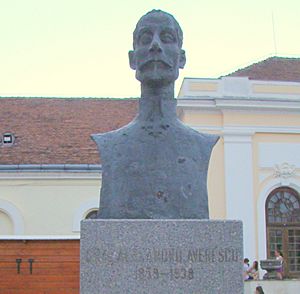
In his final years, Averescu had some disagreements with King Carol II. However, they later became friends again. In 1937, Averescu was appointed a member of the Crown Council, an important group of advisors to the king.
In 1938, he briefly served as a minister in the government formed by King Carol. He died soon after in Bucharest. He was buried in the crypt for World War I heroes in Mărăști.
Images for kids
See also
 In Spanish: Alexandru Averescu para niños
In Spanish: Alexandru Averescu para niños


